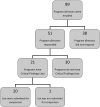Neuroradiology critical findings lists: survey of neuroradiology training programs
- PMID: 23042926
- PMCID: PMC4332716
- DOI: 10.3174/ajnr.A3300
Neuroradiology critical findings lists: survey of neuroradiology training programs
Abstract
Background and purpose: The Joint Commission has identified timely reporting of critical results as one of the National Patient Safety Goals. We surveyed directors of neuroradiology fellowships to assess and compare critical findings lists across programs.
Materials and methods: A 3-question survey was e-mailed to directors of neuroradiology fellowships with the following questions: 1) Do you currently have a "critical findings" list that you abide by in your neuroradiology division? 2) How is that list distributed to your residents and fellows for implementation, if at all? and 3) Was this list vetted by neurology, neurosurgery, and otolaryngology departments? Programs with CF lists were asked for a copy of the list. Summary and comparative statistics were calculated.
Results: Fifty-one of 89 (57.3%) programs responded. Twenty-one of 51 (41.2%) programs had CF lists. Lists were distributed during orientation, sent via Web sites and e-mails, and posted in work areas. Eleven of 21 lists were developed internally, and 5 of 21, with the input from other departments. The origin of 5 of 21 lists was unknown. Forty CF entities were seen in 20 submitted lists (mean, 9.1; range, 2-23). The most frequent entities were the following: cerebral hemorrhage (18 of 20 lists), acute stroke (15 of 20), spinal cord compression (15 of 20), brain herniation (12 of 20), and spinal fracture/instability (12 of 20). Programs with no CF lists called clinicians on the basis of "common sense" and "clinical judgment."
Conclusions: Less than a half (41.2%) of directors of neuroradiology fellowships that responded have implemented CF lists. CF lists have variable length and content and are predominantly developed by radiology departments without external input.
Figures
References
-
- Kohn LT, Corrigan JM, Donaldson MS, eds, for the Committee on Quality of Health Care in America, Institute of Medicine. To Err is Human: Building a Safer Health System. Washington, DC: National Academies Press; 1999 - PubMed
-
- Thrall JH. Quality and safety revolution in health care. Radiology 2004;233:3–6 - PubMed
-
- Choksi VR, Marn C, Piotrowski MM, et al. . Illustrating the root-cause-analysis process: creation of a safety net with a semiautomated process for the notification of critical findings in diagnostic imaging. J Am Coll Radiol 2005;2:768–76 - PubMed
-
- Johnson CD, Miranda R, Aakre KT, et al. . Process improvement: what is it, why is it important, and how is it done? AJR Am J Roentgenol 2010;194:461–68 - PubMed
-
- Greenberg CC, Regenbogen SE, Studdert DM, et al. . Patterns of communication breakdowns resulting in injury to surgical patients. J Am Coll Surg 2007;204:533–40 - PubMed
MeSH terms
Grants and funding
LinkOut - more resources
Full Text Sources


